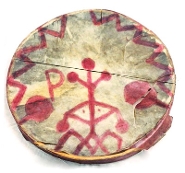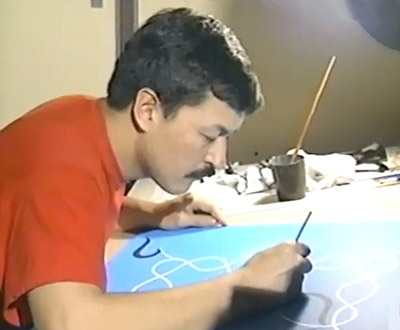Dissertation
Renewing the cultural identity of Canadian Indians
The artefacts that still remain from the traditional culture of the indigenous Yukon, Canada, are spread over dozens of museums throughout the world. Yukon Indian Ukjese van Kampen carried out research to bring this culture to light. This is the subject of his dissertation entitled ‘The history of Yukon First Nations Art’.
- Author
- Yukon Indian Ukjese van Kampen
- Date
- 23 May 2014

Hand drum of the Tuchtone tribe (1913)
Rough and barbaric
The Yukon Indians (Yukon is also the name of a department of Canada) are generally painted in Western literature as a rough, barbaric nation with no cultural tradition to speak of. In his dissertation Van Kampen shows that they have become the victim of their own modesty - they put up scarcely any resistance to the dominant culture of the North West coast - and of the bitter weather conditions that ensure that many artefacts did not stand the test of time. The aim of his research was to give back to the Yukon their cultural identify, and in so doing also their dignity and self-respect.

Story tellers
You say that the indigenous Yukon distrust Western scientists, and that, as a result, these scientists have therefore learned less about the Yukon culture than you. Why do they trust you?
‘I am one of my people. Some Elders that I spoke to for my research cared for me when I was a child. And then there's a second point: for the Yukon, the relations between people are very important. Western researchers come to us for information so that they can obtain an academic title. After that, you never see them again, but they still call themselves experts on our culture. Amazingly arrogant! A third point is that we are story tellers. Even with lengthy questionnaires, you don't get to find out everything. The Elders pass their knowledge on in the form of stories, and these stories have to be placed in their geographical, historical and cultural context.
Three style periods

You discovered three different artistic periods in the history of the Yukon. What were these periods?
‘The geometric period, that started over 7000 years ago and ended around 1840. At that time objects and tools were decorated with geometric motifs, either carved or painted. In the period immediately after this, beads and flower motifs were used. This period ended shortly before the Second World War, and was followed by the recent period. What we see now are more simple patterns based on the art of the Indians on the North West coast. The recent period has no connection with the previous two periods, and this is precisely the problem. The Yukon no longer know what their own art, the art of the central South, looked like.'
Indigenous modernist

As well as being an academic, you are also an artist. How do these two roles influence one another?
They are not separate identities; they are closely linked to one another. Leonardo da Vinci was the same. Modern science has become too analytical. I call myself an indigenous modernist: I connect influences from history, the modern time, archaeology and anthropology.'
Ukjese van Kampen is a Yukon Indian who was born in 1959 in Whitehorse (Canada) as Neil Eugene Smith. His great-grandmother recognised him as a reincarnation of her second husband, and gave him the Indian name Ukjese. As the family tree of the Yukon Indians runs via the female line, Ukjese adopted the surname of his Dutch wife.
Ukjese defends his dissertation in the traditional dress of his tribe.

